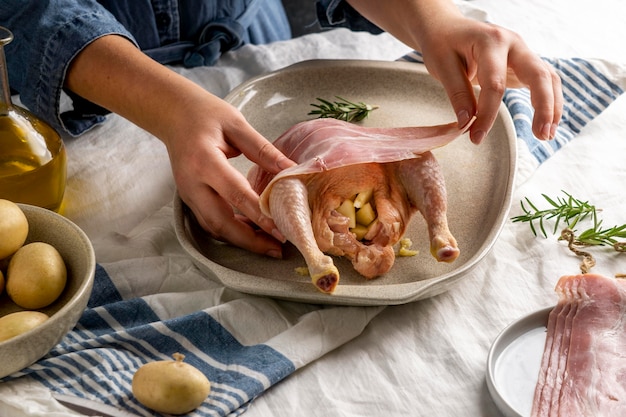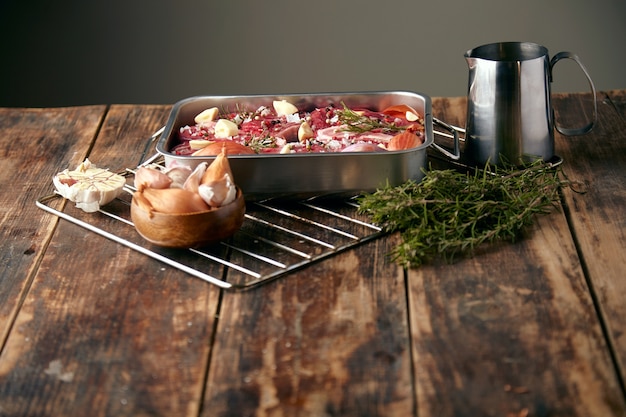Let's talk cured ham, the kind that makes your mouth water just thinking about it! It's not your typical supermarket ham, but a true culinary treasure, carefully cured and aged for weeks, sometimes months, to create that rich, salty, and oh-so-delicious flavour. The kind that you crave for special occasions, the kind that you simply can't resist.
But here's the thing: you've got this beautiful piece of ham, and you're ready to unleash its deliciousness, but you're a bit unsure about how long to cook it. How long is "long enough?" Fear not, my friend! I'm here to guide you through the process, sharing my hard-earned lessons and tips along the way. I've been through my share of ham-cooking mishaps, dry hams that were more like sandpaper than food, and undercooked hams that were frankly, a bit scary. But through trial and error, I've learned a thing or two about getting that perfect, juicy, and flavourful ham every single time.
So, let's dive in and explore the world of cured ham cooking. We'll explore different cooking methods, uncover some handy tips and tricks, and hopefully, leave you feeling confident enough to tackle any cured ham adventure that comes your way.
(Part 1) The Basics: Choosing Your Ham

Understanding Cured Ham
Before we get into the cooking, let's talk about the star of the show: cured ham. This is not just a simple piece of pork thrown in the oven. It's a carefully crafted creation that undergoes a complex process of salting, drying, and sometimes smoking, all of which contributes to its unique flavour and texture.
There are two main types of cured ham that you'll encounter:
- dry-cured ham: This is the classic, traditional method, where the ham is rubbed with salt and spices and then hung in a cool, dry environment for weeks, sometimes months. It's a slow, deliberate process that allows the moisture to evaporate, resulting in an intense, concentrated flavour and a firm, almost chewy texture. Think "Prosciutto" (Italy), "Jamón" (Spain), or "Bayonne" (France) - these are all dry-cured hams with distinct regional characteristics.
- wet-cured ham: This method involves injecting the ham with a brine solution, which speeds up the curing process. Wet-cured hams are often smoked for added flavour, resulting in a milder, more approachable flavour than their dry-cured counterparts. They tend to be more tender and juicy. Look out for terms like "country ham" or "city ham," which often refer to wet-cured hams with regional variations in their preparation.
Choosing the Right Ham
Now that you understand the basics of cured ham, it's time to choose the perfect one for your needs. The right ham depends on your personal preferences, the occasion, and the dish you're planning. Here are some factors to consider:
- Size: Think about how much ham you'll need to feed your guests. For a large gathering, a larger ham is a must, but for a smaller dinner party, a smaller ham will do the trick.
- Bone-in or Boneless: boneless ham is often easier to carve, as you don't have to worry about navigating the bone. However, bone-in ham adds extra flavour and moisture to the meat, due to the bone's role in retaining moisture during cooking. It's a matter of personal preference!
- Cut: Hams can be cut from the leg of the pig or the shoulder. Leg ham is generally leaner and more muscular, while shoulder ham is marbled with fat, giving it a more succulent and buttery texture.
Don't be afraid to ask your butcher for recommendations. They're the experts and can guide you toward the perfect ham for your specific needs.
(Part 2) Preparing Your Ham

You've chosen your ham, and now it's time to get it ready for its culinary adventure. The preparation process is fairly simple, but there are a few key steps to ensure a truly delicious result.
Removing the Packaging
First, remove the ham from its packaging and give it a thorough rinse under cold water. This helps to remove any excess salt or brine, and it freshens up the flavour. Pat the ham dry with paper towels - you want a dry surface for the next step.
Scoring the Ham
Here's where we start to get into the fun part! Scoring the fat layer of the ham is a simple yet effective technique that makes a huge difference in the final flavour and appearance. Use a sharp knife to create a criss-cross pattern in the fat. This allows the fat to render (melt) during cooking, resulting in a crispy, golden-brown crust that's both visually appealing and adds a delicious, savory depth to the flavour.
Feeling adventurous? Add a few cloves to the fat before you start scoring. The cloves will infuse the ham with a lovely aromatic flavour as it cooks.
Adding Flavor
Cured ham is naturally salty, so you don't want to overdo it with additional salt. However, you can add a touch of flavour to your ham with your favourite seasonings. Here are some ideas:
- Sweet and Smoky: Combine brown sugar, smoked paprika, and a touch of black pepper for a rich, complex glaze that complements most cured hams.
- Herby Delight: Mix fresh rosemary, thyme, and a little garlic for a fragrant and delicious ham. This combo works especially well with dry-cured hams.
- Fruity Twist: Add a sprinkle of dried cherries or cranberries for a touch of sweetness and tang. This works particularly well with wet-cured hams, balancing out the saltiness with a bit of fruitiness.
Rub the seasoning mixture into the fat layer and the outer surface of the ham, ensuring that it's evenly distributed. And there you have it - a beautifully prepared ham, ready for its star turn.
(Part 3) Roasting Your Ham

Roasting is a classic method for cooking cured ham, resulting in a moist, flavorful ham with a satisfyingly crispy outer crust. Here's how to do it right:
Preheat the Oven
Start by preheating your oven to 325°F (160°C). While the oven is getting nice and hot, place a roasting rack inside a large roasting pan. This allows the ham to cook evenly and the juices to drain away, preventing a soggy, unpleasant texture.
Place the Ham
Carefully place your beautifully prepared ham on the roasting rack. Make sure the roasting pan is large enough to accommodate the ham without the juices overflowing. You don't want to create a messy situation in your oven!
Cooking Time
Here's where things get a bit more specific. Cooking time depends on the size of your ham. A general rule of thumb is to roast it for about 15-20 minutes per pound. For example, a 10-pound ham would take roughly 2.5 to 3 hours.
But these are just guidelines. To ensure your ham is cooked to perfection, you'll want to use a meat thermometer. Insert it into the thickest part of the ham, avoiding the bone. The ham should reach an internal temperature of 145°F (63°C) for safe and delicious results.
Basting the Ham
To keep your ham moist and juicy, you can baste it every 30 minutes or so during cooking. A simple mixture of water and apple cider vinegar adds a subtle tangy flavour. If you're feeling extra fancy, try a mixture of honey, orange juice, and ginger for a sweet and citrusy glaze that will tantalize your taste buds.
Resting Time
Once the ham is cooked to perfection, resist the temptation to carve it right away! Let it rest for 15-20 minutes before carving. This allows the juices to redistribute throughout the meat, resulting in a more tender and flavorful ham. Patience, my friend, patience!
(Part 4) Baking Your Ham
Baking your ham is a similar method to roasting, but often involves less time and a lower oven temperature, particularly for smaller hams. Here's the breakdown:
Prepare the Ham
Follow the same preparation steps as for roasting: score the fat, add your chosen seasonings, and place it on a roasting rack in a baking pan.
Baking Time
For smaller hams, like those around 5-7 pounds, bake them at 300°F (150°C) for about 15 minutes per pound. So, a 5-pound ham would bake for approximately 1 hour and 15 minutes. You can also opt for a lower temperature, such as 275°F (135°C), for a longer cooking time, resulting in a more tender ham.
Monitoring the Temperature
As with roasting, use a meat thermometer to check the internal temperature of the ham. Aim for 145°F (63°C). If you notice the outer crust is getting too crispy before the ham is cooked through, cover it with foil to prevent further browning and maintain moisture.
Resting Time
After baking, let the ham rest for 15-20 minutes before carving. Just like with roasting, this allows the juices to redistribute, creating a more tender and flavorful final product.
(Part 5) Frying Your Ham
Now, this method is for those who like their ham with a bit of "oomph." Frying, especially in a cast-iron pan, creates a crispy, golden-brown crust that's both visually stunning and incredibly flavorful. It's a fantastic way to add an extra layer of texture and depth to your ham.
Preparation
For frying, I recommend using a smaller, boneless ham, something around 2-3 pounds. You'll also need a large cast-iron pan that can handle the heat.
Start by patting the ham dry and scoring the fat layer. A simple seasoning blend of salt, pepper, and a touch of paprika will enhance the natural flavour of the ham.
Frying the Ham
Heat your cast-iron pan over medium-high heat. Add a tablespoon or two of olive oil or lard to the pan, then carefully place the ham in the hot oil. Cook for about 5-7 minutes on each side, until a beautiful golden-brown crust forms.
To ensure the ham cooks evenly, use a meat thermometer to check the internal temperature. Aim for 145°F (63°C).
Resting Time
After frying, remove the ham from the pan and let it rest for 5-10 minutes before slicing. This helps the juices redistribute and keep the ham moist.
Remember, frying a whole ham can be a bit of a challenge, especially with a smaller stovetop. If your pan is too small, you can cut the ham into smaller pieces before frying.
(Part 6) Serving Your Ham
You've got your perfectly cooked ham, and now it's time to shine! How you serve it depends on the occasion and your personal preferences.
Traditional Style
The classic way to serve ham is with a side of mashed potatoes, green beans, and a sweet potato casserole. It's a comforting and satisfying combination that never fails to please.
For a touch of elegance, serve the ham on a bed of arugula salad with a tangy vinaigrette dressing. The contrast of flavours and textures elevates the ham to new heights.
Creative Options
Don't be afraid to think outside the box! Cured ham is incredibly versatile and can be incorporated into a variety of dishes.
- Dice the ham and add it to pasta dishes for a boost of savoury flavour.
- Use it in sandwiches for a delicious and satisfying filling.
- Add it to salads for a touch of salty richness.
- Incorporate it into quiche for a hearty and flavorful main course.
- Use it in breakfast hash for a savory and satisfying breakfast.
- Top pizzas with ham for a unique and delicious twist.
Leftovers
Let's face it, most of us end up with some leftover ham. Don't let it go to waste! Here are a few ideas for using up your leftovers:
- Make a delicious ham and bean soup.
- Whip up some ham and cheese omelettes for a quick and easy breakfast.
- Prepare some ham salad sandwiches for a tasty lunch.
(Part 7) ham glazing
A glaze can take your ham from good to spectacular. It adds a layer of sweetness and flavour that really enhances the ham, creating a beautiful and tempting finish. You can make your own glaze using a variety of ingredients, or you can buy a pre-made glaze from the store.
Simple Glaze Options
- honey mustard glaze: Mix honey, Dijon mustard, and a touch of apple cider vinegar for a tangy and sweet glaze.
- Maple-brown sugar glaze: Combine maple syrup, brown sugar, and a hint of cinnamon for a warm and comforting glaze.
- Orange-Ginger Glaze: Mix orange juice, grated ginger, and honey for a bright and citrusy glaze.
Glazing Technique
The key to a perfect glaze is to apply it in the last 30 minutes of cooking. You can either brush it on with a pastry brush or spoon it over the ham.
As the ham cooks, the glaze will caramelize, creating a beautiful and flavorful crust that will have everyone drooling.
(Part 8) ham carving
Carving a ham can seem a bit intimidating, but it's actually quite simple. Here's how to do it like a pro:
Tools
You'll need a sharp carving knife and a carving fork. If you're working with a bone-in ham, you'll also need a ham carving board that has a groove for catching the juices. This helps to keep the carving area clean and prevents a messy situation.
Carving Technique
For boneless ham, simply slice it into thin, even slices. For bone-in ham, start by cutting along the bone. Then, slice the ham into thin slices, following the grain of the meat. This ensures that the slices are tender and easy to chew.
Keep your fingers curled inward to avoid getting cut.
Serving
Once you've carved the ham, arrange it on a platter and serve it with your chosen sides.
(Part 9) FAQs
Here are a few frequently asked questions about cured ham cooking:
1. Can I cook a frozen ham?
It's best to thaw your ham in the refrigerator for at least 24 hours before cooking. This ensures that the ham cooks evenly and that you don't end up with any raw spots. It also helps to prevent the ham from becoming overly dry.
2. What if my ham is too salty?
If you find your ham is too salty, you can try soaking it in cold water for a few hours before cooking. This will help to draw out some of the salt. You can also try adding a bit more sugar to your glaze or serving the ham with a side dish that has a tangy flavour, like a vinegar-based salad.
3. Can I overcook a ham?
Yes, you can overcook a ham. Overcooked ham will be dry and tough. The best way to avoid overcooking is to use a meat thermometer and to cook the ham to the recommended internal temperature of 145°F (63°C). You can also try using a lower oven temperature and cooking the ham for a longer period to ensure it stays moist.
4. How long can I keep cooked ham in the fridge?
Cooked ham can be stored in the refrigerator for 3-4 days. If you're planning to keep it longer, you can freeze it for up to 2 months. Be sure to wrap it tightly in plastic wrap and aluminum foil before freezing.
5. How can I make sure my ham is cooked all the way through?
The best way to ensure your ham is cooked all the way through is to use a meat thermometer. Insert the thermometer into the thickest part of the ham, avoiding the bone. The ham should reach an internal temperature of 145°F (63°C). You can also check the ham by cutting into the thickest part with a sharp knife. The juices should run clear and the meat should be opaque, not pink.
There you have it! You're now armed with the knowledge you need to cook a delicious and impressive cured ham. So, go forth, and enjoy the wonderful world of cured ham!
Everyone is watching

Corn on the Cob: The Ultimate Guide to Perfectly Cooked Ears
Healthy MealsAh, corn on the cob. Just the name evokes images of sunny days, barbecues, and that sweet, juicy flavour that ...

Scallops: The Ultimate Guide to Perfect Cooking
Healthy MealsAh, scallops. Those delicate, sweet, and utterly delicious morsels of the sea. They hold a special place in my...

Spaghetti Squash: The Ultimate Guide to Cooking and Serving
Healthy MealsRemember that time you saw spaghetti squash at the supermarket, looking all bumpy and strange, and thought, "W...

Salmon Cooking Times: Perfect Guide for Every Recipe
Healthy MealsLet me tell you, cooking salmon is an art form. It's all about getting that perfect balance: juicy and tender,...

Ham Cooking Time: How Long to Bake, Smoke, or Boil a Delicious Ham
Healthy MealsAh, ham. It's a classic, isn't it? A real crowd-pleaser, especially around holidays. And when done right, it'...
